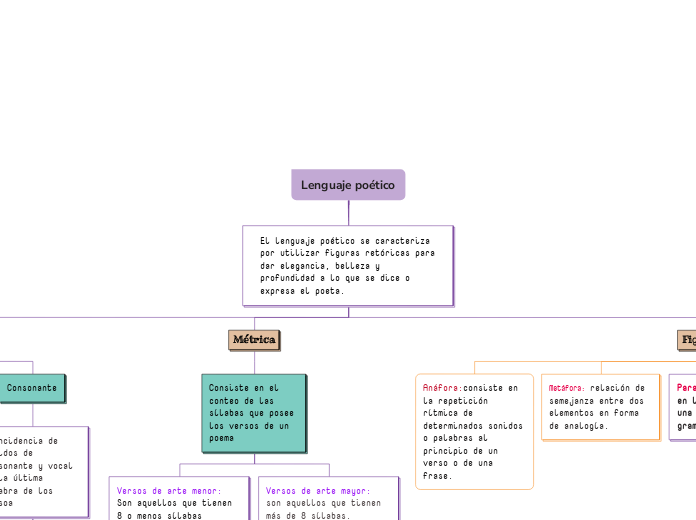Lenguaje poético
Type in the name of the multiple-perspectives text.
Example: Bridge to Terabithia by Katherine Paterson
El lenguaje poético se caracteriza por utilizar figuras retóricas para dar elegancia, belleza y profundidad a lo que se dice o expresa el poeta.
Identify an important issue from the text that is being presented from different angles. Type it in.
Example: Jesse's drawing talent.
Figuras retóricas
Whose character does the third point of view belong to?
Type in his/her name.
Example: Mr. Aarons, Jesse's father.
Personificación:atribuir características humanas a objetos o animales
Comparaciones: consiste en establecer relación entre dos cosas.
Paralelism:consiste en la repetición de una misma estructura gramatical.
Metáfora: relación de semejanza entre dos elementos en forma de analogía.
Anáfora:consiste en la repetición rítmica de determinados sonidos o palabras al principio de un verso o de una frase.
What does the character think, say or do that suggests their perspective on the issue?
Type in a quote and try to maintain the citation format.
Example: 'He would like to show his drawings to his dad, but he didn't dare. (...) He'd thought his dad would be pleased. He wasn't. What are they teaching in that damn school? he had asked.' (Paterson, 2.8)
Métrica
Decide on the second point of view
Name the character (it can either be the main character or one of the supporting characters) whose point of view you are presenting.
Example: Miss Edmunds, Jesse's music teacher.
Consiste en el conteo de las sílabas que posee los versos de un poema
Type in a quote that points out the character's position about the issue.
Try to follow a citation format: author's name, chapter, and page.
Example: 'She said he was unusually talented, and she hoped he wouldn't let anything discourage him.' (Paterson, 2. 8)
Versos de arte mayor: son aquellos que tienen más de 8 sílabas.
Versos de arte menor: Son aquellos que tienen 8 o menos sílabas
How is the viewpoint introduced in the story?
Choose an answer:
First person point of viewSecond person point of viewThird person point of viewOmniscient point of view
Rima
Decide on the first point of view you are going to present.
Type in the name of the character (it can either be the main character or one of the supporting characters) whose point of view belongs to.
Example: Jesse Oliver Aarons, Jr., the main character of the novel, a fifth-grader living in a rural Southern area.
Consonante
Coincidencia de sonidos de consonante y vocal en la última palabra de los versoa
Type of narration
Asonante
Type in a relevant quote that highlights the character's point of view towards
El lenguaje poético se caracteriza por utilizar figuras retóricas para dar elegancia, belleza y profundidad a lo que se dice o expresa el poeta..
Try following a citation format: author's name, chapter, and page.
Example: 'Jesse drew the way some people drank whiskey. (...) Lord, he loved to draw. (...) When he was in first grade, he told his father that he wanted to be an artist when he grew up.' (Paterson, 2. 7)
Coíncidencia de sonido vocálico entre las últimas palabras de los versos.
What type of narration introduces the viewpoint?
Choose an answer:
First person point of view - using the personal pronouns 'I' or 'we'Second person point of view - using the personal pronoun 'you'Third person point of view - using the third-person pronouns 'he', 'she' and 'they'Omniscient point of view - an all-seeing observer tells the story









